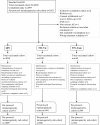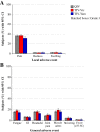Immunogenicity, reactogenicity and safety of an inactivated quadrivalent influenza vaccine candidate versus inactivated trivalent influenza vaccine: a phase III, randomized trial in adults aged ≥18 years
- PMID: 23883186
- PMCID: PMC3750613
- DOI: 10.1186/1471-2334-13-343
Immunogenicity, reactogenicity and safety of an inactivated quadrivalent influenza vaccine candidate versus inactivated trivalent influenza vaccine: a phase III, randomized trial in adults aged ≥18 years
Abstract
Background: Two antigenically distinct influenza B lineages have co-circulated since the 1980s, yet inactivated trivalent influenza vaccines (TIVs) include strains of influenza A/H1N1, A/H3N2, and only one influenza B from either the Victoria or Yamagata lineage. This means that exposure to B-lineage viruses mismatched to the TIV is frequent, reducing vaccine protection. Formulations including both influenza B lineages could improve protection against circulating influenza B viruses. We assessed a candidate inactivated quadrivalent influenza vaccine (QIV) containing both B lineages versus TIV in adults in stable health.
Methods: A total of 4659 adults were randomized 5:5:5:5:3 to receive one dose of QIV (one of three lots) or a TIV containing either a B/Victoria or B/Yamagata strain. Hemagglutination-inhibition assays were performed pre-vaccination and 21-days after vaccination. Lot-to-lot consistency of QIV was assessed based on geometric mean titers (GMT). For QIV versus TIV, non-inferiority against the three shared strains was demonstrated if the 95% confidence interval (CI) upper limit for the GMT ratio was ≤1.5 and for the seroconversion difference was ≤10.0%; superiority of QIV versus TIV for the alternate B lineage was demonstrated if the 95% CI lower limit for the GMT ratio was > 1.0 and for the seroconversion difference was > 0%. Reactogenicity and safety profile of each vaccine were assessed. Clinicaltrials.gov: NCT01204671.
Results: Consistent immunogenicity was demonstrated for the three QIV lots. QIV was non-inferior to TIV for the shared vaccine strains, and was superior for the added alternate-lineage B strains. QIV elicited robust immune responses against all four vaccine strains; the seroconversion rates were 77.5% (A/H1N1), 71.5% (A/H3N2), 58.1% (B/Victoria), and 61.7% (B/Yamagata). The reactogenicity and safety profile of QIV was consistent with TIV.
Conclusions: QIV provided superior immunogenicity for the additional B strain compared with TIV, without interfering with antibody responses to the three shared antigens. The additional antigen did not appear to alter the safety profile of QIV compared with TIV. This suggests that the candidate QIV is a viable alternative to TIV for use in adults, and could potentially improve protection against influenza B.
Trial registration: Clinical Trials.gov: NCT01204671/114269.
Figures




Similar articles
-
Immunogenicity, reactogenicity, and safety of inactivated quadrivalent influenza vaccine candidate versus inactivated trivalent influenza vaccine in healthy adults aged ≥18 years: a phase III, randomized trial.Vaccine. 2014 Mar 14;32(13):1480-7. doi: 10.1016/j.vaccine.2014.01.022. Epub 2014 Jan 28. Vaccine. 2014. PMID: 24486352 Clinical Trial.
-
A randomized trial of candidate inactivated quadrivalent influenza vaccine versus trivalent influenza vaccines in children aged 3-17 years.J Infect Dis. 2013 Jun 15;207(12):1878-87. doi: 10.1093/infdis/jit091. Epub 2013 Mar 7. J Infect Dis. 2013. PMID: 23470848 Free PMC article. Clinical Trial.
-
Immunogenicity and safety of an egg-based inactivated quadrivalent influenza vaccine (GC3110A) versus two inactivated trivalent influenza vaccines with alternate B strains: A phase Ⅲ randomized clinical trial in adults.Hum Vaccin Immunother. 2019;15(3):710-716. doi: 10.1080/21645515.2018.1536589. Epub 2018 Nov 15. Hum Vaccin Immunother. 2019. PMID: 30396317 Free PMC article. Clinical Trial.
-
Comparison of the immunogenicity and safety of quadrivalent and tetravalent influenza vaccines in children and adolescents.Vaccine. 2020 Feb 5;38(6):1332-1344. doi: 10.1016/j.vaccine.2019.11.071. Epub 2020 Jan 14. Vaccine. 2020. PMID: 31948819 Review.
-
[Immunogenicity of inacitivated quadrivalent influenza vaccine in adults aged 18-64 years: A systematic review and Meta-analysis].Zhonghua Liu Xing Bing Xue Za Zhi. 2018 Dec 10;39(12):1636-1641. doi: 10.3760/cma.j.issn.0254-6450.2018.12.019. Zhonghua Liu Xing Bing Xue Za Zhi. 2018. PMID: 30572392 Chinese.
Cited by
-
Assessment of an optimized manufacturing process for inactivated quadrivalent influenza vaccine: a phase III, randomized, double-blind, safety and immunogenicity study in children and adults.BMC Infect Dis. 2018 Apr 18;18(1):186. doi: 10.1186/s12879-018-3079-8. BMC Infect Dis. 2018. PMID: 29669531 Free PMC article. Clinical Trial.
-
Immunogenicity of Split Inactivated Quadrivalent Influenza Vaccine in Adults with Obesity in the 2017/2018 Season.Med Sci Monit. 2021 May 17;27:e929572. doi: 10.12659/MSM.929572. Med Sci Monit. 2021. PMID: 33994536 Free PMC article.
-
Immunogenicity and safety of a quadrivalent plant-derived virus like particle influenza vaccine candidate-Two randomized Phase II clinical trials in 18 to 49 and ≥50 years old adults.PLoS One. 2019 Jun 5;14(6):e0216533. doi: 10.1371/journal.pone.0216533. eCollection 2019. PLoS One. 2019. PMID: 31166987 Free PMC article. Clinical Trial.
-
Quadrivalent influenza vaccine in the United States.Hum Vaccin Immunother. 2014;10(3):596-99. doi: 10.4161/hv.27115. Epub 2013 Nov 14. Hum Vaccin Immunother. 2014. PMID: 24231756 Free PMC article.
-
Respiratory Viral Infections in Solid Organ and Hematopoietic Stem Cell Transplantation.Clin Chest Med. 2017 Dec;38(4):707-726. doi: 10.1016/j.ccm.2017.07.012. Epub 2017 Sep 20. Clin Chest Med. 2017. PMID: 29128020 Free PMC article. Review.
References
-
- Fiore AE, Uyeki TM, Broder K, Finelli L, Euler GL, Singleton JA, Iskander JK, Wortley PM, Shay DK, Bresee JS. et al.Prevention and control of influenza with vaccines: recommendations of the advisory committee on immunization practices (ACIP), 2010. MMWR Recomm Rep. 2010;59(RR-8):1–62. - PubMed
-
- Ampofo WK, Baylor N, Cobey S, Cox NJ, Daves S, Edwards S, Ferguson N, Grohmann G, Hay A, Katz J. et al.Improving influenza vaccine virus selection: report of a WHO informal consultation held at WHO headquarters, Geneva, Switzerland, 14–16 June 2010. Influenza Other Respi Viruses. 2012;6(2):142–152. e141-145. - PMC - PubMed
Publication types
MeSH terms
Substances
Associated data
LinkOut - more resources
Full Text Sources
Other Literature Sources
Medical

